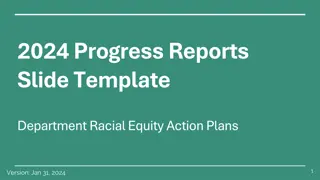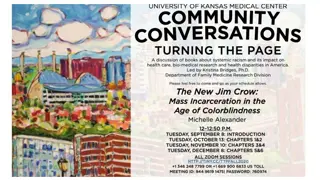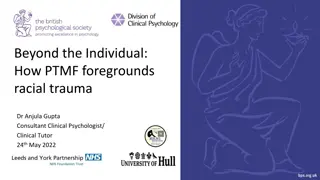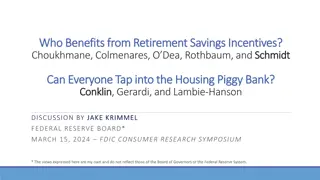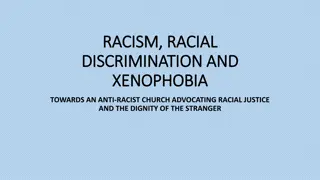
Racial Equity Committee 2023 Draft Work Plan Summary
This draft work plan outlines the goals and ongoing initiatives of the Racial Equity Committee, focusing on incorporating racial equity into various aspects, exploring intersectionality data, providing training opportunities, and promoting staff and leadership diversity. The plan includes strategies for advancing racial equity within the organization and collaborating with other communities to address homelessness effectively.
Download Presentation

Please find below an Image/Link to download the presentation.
The content on the website is provided AS IS for your information and personal use only. It may not be sold, licensed, or shared on other websites without obtaining consent from the author. If you encounter any issues during the download, it is possible that the publisher has removed the file from their server.
You are allowed to download the files provided on this website for personal or commercial use, subject to the condition that they are used lawfully. All files are the property of their respective owners.
The content on the website is provided AS IS for your information and personal use only. It may not be sold, licensed, or shared on other websites without obtaining consent from the author.
E N D
Presentation Transcript
Furman, Gregg, and the Modern Death Penalty; and some background Jan 13, 2025 Note: We may not finish all these slides today. But by Wednesday, we ll be caught up. Baumgartner, POLI 203, Spring 2025 1
Preliminary matters Announcements: Course registration hassles: Keep trying on ConnectCarolina, as there is typically some churning in the first 2 weeks. Books sold out? They are available on Canvas, POLI203.001, course reserves. Review the results of the first day survey (see separate slides) You are relatively left-wing, compared to the US population. Good thing you are in this class, because your answers to factual questions were correct only about 1/3 of the time. Considering that you are relatively educated people (you got into Carolina so you must have studied at least some in high school), and the fact that you are at least somewhat interested in the topic (since you registered for this class) that s a pretty low level of knowledge Imagine what it is among the general public. Questions before we start? Baumgartner, POLI 203, Spring 2025 2
The long, long history of the death penalty in America First prison in the US was built in Philadelphia in 1829. Before prisons, what did we do with criminals? Jails (detention until the trial), but no prisons for long-term confinement. Banishment, scarlet letters, physical punishments: Stocks, blockades, 30 lashes, other forms of torture, or death Death for: property crimes (robbery, horse thievery, rustling); morality crimes (adultery, religious violations ) Assault, rape, murder as well. (Today, only murder) Baumgartner, POLI 203, Spring 2025 3
Federalism Generally speaking, as European nations formed themselves, the national leader (generally, King) reserved for themselves the most powerful sanction, death. Only the king could kill. US: it was reserved for the colonial powers, and today it s generally the states, not the federal government. Interesting possibility: If we did not have federalism, we probably would not have the death penalty. See Garland, David. 2005. Capital Punishment and American Culture. Punishment and Society 7, 4: 347 376. Garland, David. 2012. Peculiar Institution: America s Death Penalty in an Age of Abolition. Cambridge: Harvard University Press. Baumgartner, POLI 203, Spring 2025 4
Executions before 1972. Peak of 198 in 1935, steep decline after WW2. None after 1967 through 1977. Baumgartner, POLI 203, Spring 2025 5
Why did executions rise so sharply in the early 1900s? They were replacing lynchings. Seriously. Lynchings peaked in about 1890. Southern states in particular realized they were getting bad press nationally. Why not bring the process inside the legal system: legal lynchings ? Lots of literature on this; the expansion of the system was largely an effort to restrain lynch mobs and to demonstrate that the legal system could handle these issues and there was no need for vigilantism. Baumgartner, POLI 203, Spring 2025 6
Hanging, then electric chair, some gas (lethal injection later) Baumgartner, POLI 203, Spring 2025 8
Method Hanging Electric chair Gas chamber Firing squad Burned at the stake Broken on the wheel Gibbetted Hung in chains Bludgeoned Pressed Other, misc, unknown Number 9,322 4,281 582 141 66 12 Forms of execution, before 1972 6 6 2 1 24 Baumgartner, POLI 203, Spring 2025 Total 14,446 9
A male thing: 97.5 percent. But note 1692, 14 women executed for the crime of witchcraft. Baumgartner, POLI 203, Spring 2025 10
By Race: 51% Black 43 % White (Latinx probably inaccurate.) Baumgartner, POLI 203, Spring 2025 11
No question that the framers envisioned a system with capital punishment. So, original intent scholars have a strong point. The constitution explicitly refers to capital punishments, so therefore we can assume that the founders understood we would have capital punishment and that they were comfortable with that. Current original intent legal theorists point this out commonly. On the other hand, the court has made arguments about evolving standards of decency and there are other elements in the constitution that appear to rule out capital punishment in some circumstances. Let s look at the constitution for a minute Baumgartner, POLI 203, Spring 2025 12
5th Amendment No person shall be held to answer for a capital, or otherwise infamous crime, unless on a presentment or indictment of a Grand Jury, except in cases arising in the land or naval forces, or in the Militia, when in actual service in time of War or public danger; nor shall any person be subject for the same offense to be twice put in jeopardy of life or limb; nor shall be compelled in any criminal case to be a witness against himself, nor be deprived of life, liberty, or property, without due process of law; nor shall private property be taken for public use, without just compensation. Baumgartner, POLI 203, Spring 2025 13
8th and 14th Amendments #8: Excessive bail shall not be required, nor excessive fines imposed, nor cruel and unusual punishments inflicted. #14: All persons born or naturalized in the United States, and subject to the jurisdiction thereof, are citizens of the United States and of the State wherein they reside. No State shall make or enforce any law which shall abridge the privileges or immunities of citizens of the United States; nor shall any State deprive any person of life, liberty, or property, without due process of law; nor deny to any person within its jurisdiction the equal protection of the laws. Baumgartner, POLI 203, Spring 2025 14
The Framers Clearly Envisioned Capital Punishment Common punishments in 1790: Slice off parts of the ear, cut off a hand Boil in oil Stockade, blocks, 50 lashes We don t allow those punishments anymore. But with the constitution explicitly referring to capital punishment, this is a hard sell. The justices argued explicitly about this in 1972. No doubt about original intent Baumgartner, POLI 203, Spring 2025 15
Furman v. Georgia, 1972 Actually several cases: Furman v. Georgia, Jackson v. Georgia, Branch v. Texas, Aikens v. California Aikens v. California was a very bad case a very horrific set of facts but was rendered moot just before the USSC ruled, as the California SC ruled on April 24, 1972 the state s death penalty unconstitutional under the state constitution s ban on cruel OR unusual punishments; see People v. Anderson (1972). So, while arguments were heard on this in Jan 1972, by the time the USSC ruled on June 29, 1972, Aikens was no longer on death row.) California s death row was large, included Sirhan Sirhan, Charles Manson, others. Baumgartner, POLI 203, Spring 2025 16
Furman v. Georgia Furman, a black man, was convicted of killing a white homeowner during a burglary. He said it was unintentional, shooting his gun while he tripped, attempting to flee. But the homeowner died. (Crime: 1967, sentence 1968, one-day trial.) The jury had complete discretion to impose death or not, and it sentenced him to death. After all, it was felony murder . Multiple, different, opinions by each of the justices, none with more than 3 agreeing to sign. 5-4 decision nonetheless invalidates every existing law, empties the nation s death rows (700 inmates resentenced to life). Only two justices say the death penalty is, in all circumstances, unconstitutional. Others have different logics, and don t go this far. Baumgartner, POLI 203, Spring 2025 17
5: Brennan, Stewart, White, Marshall, Douglas 4: Burger, Blackmun, Powell, Rehnquist Baumgartner, POLI 203, Spring 2025 18
Wonton and freakish, like being struck by lightning (among convicted murderers) One justice s opinion focuses on the capricious and arbitrary nature of the punishment Many of those given the death penalty are NOT guilty of the most heinous crimes. Concern about impact of race here, but no clear finding that race drives it. No procedural safeguards to guarantee fairness Extreme rarity of the punishment: who gets selected, it is like being struck by lightning Note: One solution to this freakishness would be to make the death penalty mandatory. North Carolina did this, in fact, in response to the ruling. Baumgartner, POLI 203, Spring 2025 19
Deterrence Is it acceptable to punish on person more severely just to make an example ? Does that mean that we are treating a human life as an object, merely a means to an end? Is it constitutionally acceptable to treat a person as an object, or is that inhumane? Given the low rate of usage of capital punishment, is there any deterrent value, anyway? Note that the first two concerns apply even if there is a deterrent value. (We will return to deterrence later, but this is what they argued in Furman: even if there is deterrence, is that a reason to kill someone, to make an example?) Baumgartner, POLI 203, Spring 2025 20
As many decisions / opinions as justices, almost. Inherently unconstitutional under all circumstances: Brennan and Marshall Capricious and arbitrary: Brennan, Stewart, White, Marshall, Douglass No deterrent effect: White, Marshall, Brennan A 4 part test: Brennan (A punishment does not comport with human dignity if it is: Unusually severe Inflicted arbitrarily Substantially rejected by contemporary society No more effective than a less severe punishment) (We will come back to this idea of penological value later in the term) Evolving standards of decency: several justices The dissenters: Poppycock! Original intent, popular sentiment, deterrence, legislative rights, state s rights (Burger, Blackmun, Powell, Renquist) Baumgartner, POLI 203, Spring 2025 21
Five Justices, Five Reasonings Brennan Stewart White Marshall Douglas X X X X X Capricious X X X Racially Biased X X No Deterrent Value X X X X Cruel / inhumane X X X Retributive only Would eliminate capital punishment in the abstract X X Baumgartner, POLI 203, Spring 2025 22
Four dissenters, including the Chief Justice (Warren Burger) Elected officials have passed these laws, this is clear judicial over-reach 14thamendment clearly mentions deprive of life so the constitution assumes that capital punishment is possible. (5th amendment also refers to capital crimes) All four appointed by Pres. Nixon Clearly foreshadow the original intent argument that the constitution does not evolve Burger s dissent provides road-map for acceptable laws in the future: narrow targeting, proportionality guarantees Baumgartner, POLI 203, Spring 2025 23
Compare Furman to Brown v. Board Often, people say that the Court will try to have a unanimous decision when it knows the decision will test its legitimacy Brown v. Board, 1954, very controversial, but united, unanimous Furman v. Georgia, 1972, pretty much the opposite Emptied all US death rows, but with no single compelling logic. And the response was furious, especially from the South (and the right) Baumgartner, POLI 203, Spring 2025 24
The response, wow was that fast! Florida reenacted before the end of 1972, and by 1976 the majority of states had reenacted their laws. Baumgartner, POLI 203, Spring 2025 25
Gregg v. Georgia, 1976 Also a combination of cases: Gregg v. Georgia Profitt v. Florida Jurek v. Texas Roberts v. Louisiana Woodson v. North Carolina First 3 affirmed, last two shot down (mandatory death for all eligible) Baumgartner, POLI 203, Spring 2025 26
Fixing the flaws of Furman Narrow Targeting Specify only the most heinous crimes Substantial proportion Don t just pick out a few; that allows too much room for bias and caprice Aggravators weighed against mitigators Most awful crimes, most deserving criminals, both Two stage trial: Guilt, then punishment, separately (with same jury) Proportionality (state Supreme Court review and approval needed) Make the punishment fit the crime, only use it for the most deserving Federal review (No execution before review by state supreme court AND federal court) Baumgartner, POLI 203, Spring 2025 27
But, wait, Jurek v. Texas was also affirmed Texas had a different system than Georgia and Florida Limited crimes But instead of aggravators and mitigators, Texas asked the jury to contemplate future dangerousness and to sentence to death if they found it. So, clearly, the Court was willing to approve a number of approaches. Texas argued that discussing future dangerousness allowed jurors to consider mitigators, though the statute never mentions is. Only NC and Louisiana s mandatory schemes were ruled out. Baumgartner, POLI 203, Spring 2025 28
McGautha v. California (1971), and the line between life and death Even after Gregg, the Court never said that there was a clear line between when a jury or a judge should rule for death or rule for life: Drawing that line, and expressing it in writing, appear to be tasks which are beyond present human ability the factors which determine [life or death] are too complex to be expressed within the limits of a simple formula So, no list of mitigating factors. Aggs must be listed but Mits are unlimited. No clear instructions to juries or judges are possible. I m not kidding. There really is no judicial standard. Baumgartner, POLI 203, Spring 2025 29
The Marshall hypothesis Justice Thurgood Marshall was the only one who had defended people, himself, personally, as an attorney. His opinion is particularly interesting, as it is much more informed by experience. Discussion of public opinion: I don t care if public opinion is positive; people don t know how it works. If they knew, they would not support it. Marshall hypothesis: If people knew how the death penalty were really implemented, they would not support it. This implies that public opinion does not matter, since the first condition is not met. (See the slides about your own collective knowledge!) Baumgartner, POLI 203, Spring 2025 30
OK, the big puzzle for this class In Furman, they say it s arbitrary, flawed, no useful purpose. In Gregg they say it must be limited to only the most serious crimes, and only for the most deserving criminals Narrow targeting on the worst of the worst Substantial proportion of those eligible get it (but still some room for grace by the jury) Now, in 2025, that makes 50 years from 1976, and 1,608 executions. The goal of the book is to assess whether we meet the promise of Gregg, or flunk the test laid out in Furman. Baumgartner, POLI 203, Spring 2025 31

